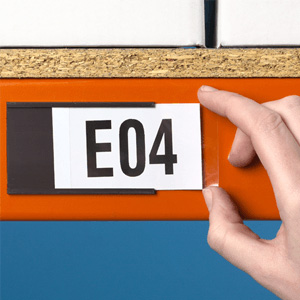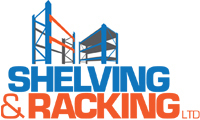Whether you’re overseeing a small warehouse or a large distribution centre, maintaining an organised and well-labelled environment is essential for streamlined operations. An effective labelling system can enhance accuracy, efficiency, safety, and customer satisfaction. If you’re in the process of setting up or looking to improve your existing system get in touch with our sales team on 0800 612 3210 or send us an enquiry Continue reading this guide to understand the significance of warehouse labelling the correct way and how we can help you implement it in your business.
Warehouse Labelling Systems
What is a Warehouse Labelling System?
Using a good warehouse labelling system can help your business in many ways. A warehouse labelling system involves the process of marking and identifying storage locations and products within a warehouse or distribution centre. Labels can be placed on floors, pallet racking, shelves, bins, and even individual products or pallets to clearly indicate their location and contents.
Why do I need a Warehouse Labelling System?
A well-designed warehouse labelling system is crucial for helping employees quickly and easily find products and materials. This boosts efficiency and productivity while reducing errors and accidents from misplaced or mishandled items. Additionally, an effective labelling system helps businesses optimise space, reduce clutter, and improve organisation.
What are the types of Warehouse Labelling Systems?
There are various types of warehouse labelling available, including:
Pallet racking labels identify individual shelves or bays. They are usually made of polyester, paper, or vinyl and are often placed in label holders to protect them from wear and tear. These labels attach to pallet racking using magnets or adhesive.
Aisle and bay markers identify large sections of the warehouse. These labels, which can be attached to the floor, ceiling or directly onto pallet racking, often use numbers, letters, or colour codes. Floor marking tape can also be used a cost effective way to mark out areas.
Floor labels mark aisles, walkways, and traffic lanes in the warehouse. Made of durable materials like vinyl or polyester, they often feature arrows, numbers, or symbols to guide traffic. Floor labels can also be as simple as floor marking tape to mark out pedestrian areas of a warehouse.
Pallet labels identify individual pallets and their contents. These labels may include information like the product name, SKU, lot number, and expiration date.
Regardless of the type of warehouse labelling system you use, the goal is to enable employees to quickly and accurately find products and materials.
Choosing the Correct Warehouse Labelling System for Your Business
Assess Your Needs
Before choosing warehouse labels, consider your specific needs by asking yourself:
- What products or materials do we store?
- How much space do we have?
- How often do we move inventory?
- What kind of traffic flow is needed?
- What level of security is necessary?
Understanding these factors will help you select the right labels for your business and ensure that you are labelling your warehouse in the correct way.
Assess Materials and Durability
When choosing warehouse labels, think about the materials and durability. Labels in harsh environments or frequent handling may need durable materials like polyester. For less demanding environments, cheaper materials like paper or vinyl may work.
What type of fixing do you need?
Consider the fixing method for your warehouse labels. Self-adhesive labels are permanent, while magnetic labels can be easily removed or repositioned as needed.
Consider Size and Visibility
Labels that are too small can be hard to read and may lack information, while labels that are too large can take up too much space. Place labels in visible locations so employees can quickly find the information they need.
Customisation
Finally, think about whether you need custom labels with your company logo, branding, or specific product details. Custom labels can boost brand recognition and help employees easily identify products or materials.
By assessing these factors and choosing the right warehouse labels, you can make your labelling system effective and efficient.
Setting Up a Warehouse Labelling System
Setting up a warehouse labeling system can seem daunting, but it doesn’t have to be. Follow these steps for a successful implementation:
Planning
Before labelling your warehouse, plan your layout. Consider the size and shape of your space, the type of products you store, and the traffic flow. This will help you choose the best locations and types of labels.
Selecting Your Labels
Once you’ve planned your layout, select your labels. Think about factors already outlined like material, durability, fixing method, size, visibility, and customisation.
Create a Labelling Plan
After selecting your labels, create a labelling plan. Decide what information each label will contain, like product details, location, and safety info. Plan where to place each label and ensure consistency across your warehouse.
Train Your Employees
Training your employees on the new labelling system is vital. Ensure everyone understands the plan and how to read and interpret the labels. This boosts efficiency and accuracy in your warehouse.
Assess, Maintain and Update
Lastly, regularly assess, maintain, and update your labelling system. This helps identify areas for improvement and ensures it meets your needs.
By following these steps, you can establish a successful warehouse labelling system that boosts efficiency and productivity in your business.
In summary, a warehouse labelling system is essential for an efficient and well-organised warehouse or distribution centre. Tailoring a labelling system to your needs can enhance efficiency, safety, and space optimisation.
Consider factors like material, durability, fixing method, size, visibility, and customisation when choosing warehouse labels. Making informed decisions ensures an effective and efficient labelling system for your business.
At Shelving & Racking, we provide a variety of warehouse labels to meet your needs. From location markers to pallet rack labels, our products are designed to streamline operations and help you achieve your goals. Contact us today to discuss your requirements.


Cart